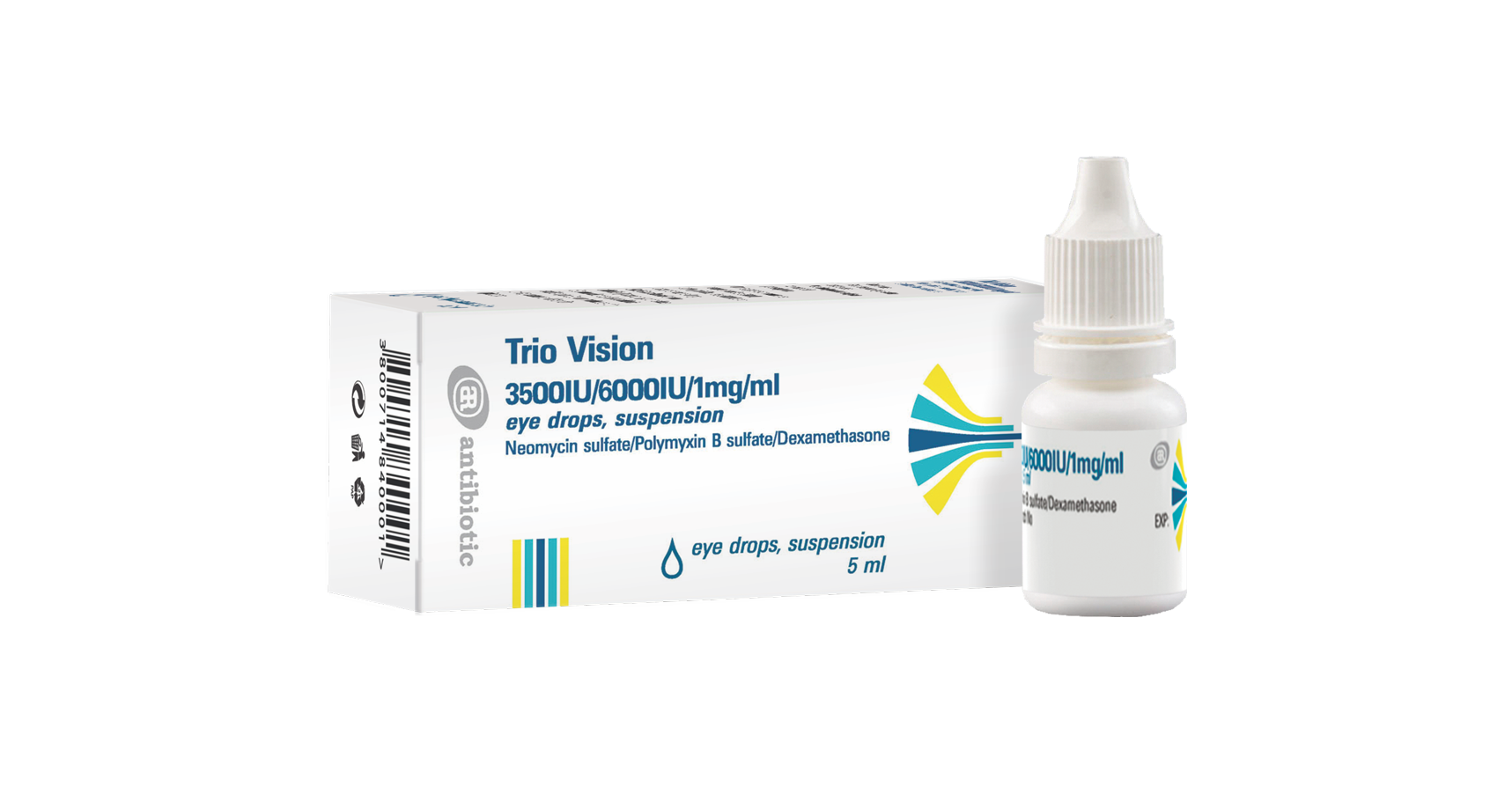
Ingredients:
3500 IU / 6000 IU / 1mg / ml:
– Neomycin sulfate:
– Polymyxin B sulfate:
– Dexamethasone:
Trio Vision eye drops have a dual effect: antimicrobial due to the presence of two antibiotics, neomycin and polymysin B, and anti-inflammatory due to the corticosteroid dexamethasone.
The most sensitive strains:
Aerobic Gr +:
Aerobic 35e Gy:
Pharmacokinetics.
Absorption after topical application may cause systemic effects. Infiltration of dexamethasone has been found to be effective in inflammatory diseases of the primary part of the eyes. Although the intact corneal epithelium prevents penetration into the corneal stroma, therapeutic concentrations penetrate the stroma when the epithelium is damaged. Absorption through the wound surface has been reported.
Auxiliary materials:
Benzalkonium chloride, tyloxapol, sodium chloride, hydrochloric acid, sodium hydroxide, water for injections.
Interaction with other medical devices.
Concomitant use of topical corticosteroids and NSAIDs may increase the risk of complications related to the corneal healing process. Dexamethasone plasma levels may be elevated in patients receiving ritonavir. Concomitant and/or administration of aminoglycosides (neomycin) and other systemic, oral or local drugs with neurotoxic, ototoxic and nephrotoxic effects may increase their adverse effects. When using more than one drug, it is recommended to keep a five-minute interval between injections.
Indications:
Contraindications:
Special instructions and precautions:
In some patients, there is increased sensitivity to topical aminoglycosides such as neomycin (manifested by edema, eyelid itching, conjunctival erythema). If a hypersensitivity reaction develops during the use of the drug, the treatment should be stopped.
Special instructions: Cross-sensitivity to other aminoglyazides is possible. The drug should be prescribed with caution in patients receiving treatment with aminoglycosides or polymyxin B. Long-term use of drops containing corticosteroids can cause increased intraocular pressure and/or glaucoma due to damage to the optic nerve, decreased visual acuity, defects of the visual field and posterior subcapsular, cataract formation; Patients receiving long-term eye drops containing corticosteroids should be monitored regularly to determine eye pressure levels. This is especially important in children, as the risk of corticoid-induced intraocular pressure increases is higher and develops more rapidly than in adults.
Predisposed patients, including children and those receiving ritonavir, may develop Cushing’s syndrome and adrenal insufficiency with long-term therapy with eye drops containing corticosteroids. In these cases, it is necessary to cancel the drug by gradually reducing the dose until the drug is completely stopped. Corticosteroids can suppress the patient’s immune response to bacterial, viral, and fungal infections, making diagnosis difficult. The appearance of non-healing ulcers on the cornea after long-term treatment with steroid drugs may indicate the development of fungal invasion. In this case, the use of the drug should be stopped. When using the drug in patients with glaucoma, treatment should be limited to two weeks with mandatory monitoring of intraocular pressure. Using eye drops containing corticosteroids can slow the healing process of the cornea. You should stop wearing contact lenses during therapy with Trio Vision. Trio Vision eye drop suspension contains benzalkonium chloride, which can irritate the eyes and is known to discolor soft contact lenses.
Side reactions:
Dosage and method of use.
Adults (including people over 65) instill 1-2 drops in the conjunctival sac 4-6 times a day. Dosage frequency should be reduced gradually, depending on the clinic. Treatment cannot be stopped prematurely. In case of severe symptoms, drip 1-2 drops every hour, with a gradual decrease in the dose, until the symptoms of inflammation disappear.
A special group of patients. Patients with damaged liver and kidneys. The effect of the drug in patients with this combination has not been studied.
Pediatrics.
Safety and efficacy in pediatric practice have not been studied.
Method of application.
Shake the bottle before use.
Pregnancy and lactation.
An antibiotic from the group of aminoglycosides, neomuin, passes through the placenta, enters intravenously in pregnant women. Systemic use of aminoglycosides leads to nephrotoxicity and ototoxicity. Long-term or periodic use of corticosteroids during pregnancy is associated with an increased risk of intrauterine growth retardation. Trio Vision eye drops are not recommended for pregnant patients. There are no known cases of excretion of eye drops with dexamethasone, neomycin, and polymyxin B in breast milk. Aminoglycosides are excreted in breast milk only after systemic administration. It is possible to use Trio Vision during lactation if the intended benefit for the mother is higher than the potential risk for the child.
Influence on the ability to drive a car and other mechanisms.
Trio Vision does not affect the ability to drive or operate machinery. A temporary feeling of blur before the eyes or other visual disturbances may occur, in the presence of which you should wait for their disappearance.
Shelf life 2 years from the date of manufacture. Store below 25°C for 28 days after opening.
Storage conditions. Keep out of reach of children at temperature below 25 °C. Do not freeze!
Manufacturer: Antibiotic-Razgrad AD, Bulgaria
Importer: “DEMI PHARM” LLC, PA 0051, St. Nairi Zaryan, 22 * www.demipharm.am